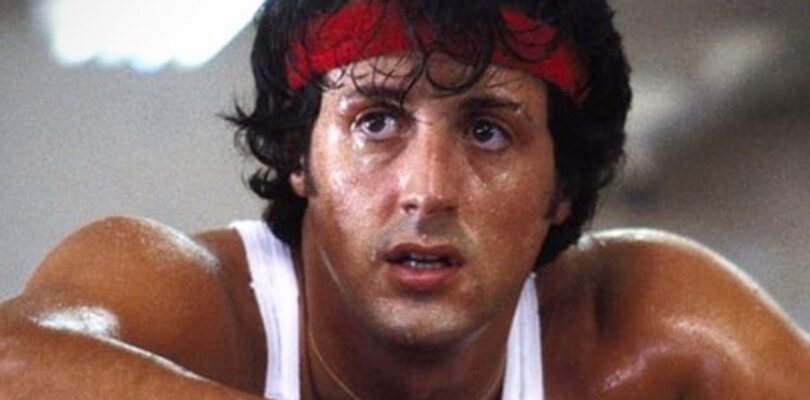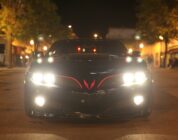On March 24th, 1975, struggling actor Sylvester Stallone spent his last few dollars to see boxing champ Muhammad Ali fight Chuck Wepner. Thought to be an easy win, Ali surprisingly met his match: a career brawler who was having the fight of his life. Fifteen rounds and an Ali knockdown later, Wepner lost. But the scrappy no name fighter inspired Stallone, who emerged from a twenty-hour writing binge with a screenplay and an underdog character named Rocky Balboa.
 The script quickly became a hot property in Hollywood, and several attempts were made to purchase it for stars like Burt Reynolds and Ryan O’Neal. But Stallone refused, knowing full well that no one could play the part like he could. Stallone eventually got his wish at United Artists, and under director John G. Avildsen, the rest became movie history. Released in 1976, Rocky was a global sensation, winning a Best Picture Oscar and establishing Stallone as a household name. The Italian Stallion was here to stay.
The script quickly became a hot property in Hollywood, and several attempts were made to purchase it for stars like Burt Reynolds and Ryan O’Neal. But Stallone refused, knowing full well that no one could play the part like he could. Stallone eventually got his wish at United Artists, and under director John G. Avildsen, the rest became movie history. Released in 1976, Rocky was a global sensation, winning a Best Picture Oscar and establishing Stallone as a household name. The Italian Stallion was here to stay.
It’s been almost four decades since that first fight with Apollo Creed, but Rocky Balboa continues to live in the minds of movie fans today. The Philadelphia boy has battled everything from personal demons to the Soviet Union, but through it all, his undying American spirit has emerged victorious. That mean southpaw hook probably helped a bit, too. Stallone, who’s directed four of the saga’s entries himself, clearly understands the appeal of his creation: a flawed everyman who just happens to be a dynamite boxer.
Rocky, now the manager his beloved Mickey (Burgess Meredith) once was, returns for a seventh outing with this Thanksgiving’s Creed. And we couldn’t be happier to see him. But before we move forward, it’s best to go back and refresh ourselves on the magical career of Philly’s favorite son. Let’s get ready to rumble. Or in this case, remember the Rocky film saga.
[divider]
Rocky (1976)
“Apollo Creed meets the Italian Stallion. Sounds like a damn monster movie.” – Apollo
Apollo Creed may have been seeking out creature feature excitement, but 1976’s Rocky is a true blue drama. Blending in equal parts On The Waterfront (1954), Marty (1955), and Somebody Up There Likes Me (1956), Stallone’s script doesn’t try to dodge 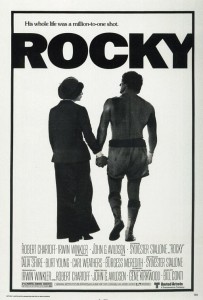 it’s Hollywood influence. Instead, it defies cliche through sincerity and sheer craft. Everyone knows the story, but here it is anyway:
it’s Hollywood influence. Instead, it defies cliche through sincerity and sheer craft. Everyone knows the story, but here it is anyway:
Rocky is a bum, plain and simple. He’s an amateur boxer, and an even less skilled mob enforcer. He can’t even maintain locker payment at Mickey’s low-rent gym. But fate comes knocking when heavyweight champ Apollo (Carl Weathers) needs a last minute replacement, someone who can make for good publicity. Local boy Balboa wins the chance, solely on the strength of his nickname – The Italian Stallion. Only in America!
It’s a million-to-one shot, but Stallone and his director make it flow like fresh blood from a boxing glove. Avildsen maximizes the film’s few block radius, painting lonely images of the streets of Philadelphia as if they were part of a modern fable, eventually building to that famous run up the Art Museum steps. As the finale to what would become the first of many montages, Rocky’s victorious arm raise has become synonymous with cinematic magic. Stallone, both as an actor and screenwriter, nails just the right mix of aloofness and insight to win over the world (and Academy voters, securing an Oscar nod). He was right, no one could’ve played the part better than him.
The concluding boxing match is spectacular, aided by early use of the steadicam. Rocky eventually loses, but the vindication was in the attempt all along – he had finally proven that he wasn’t “just another bum from the neighborhood.” It’s corny, sure, but like the film itself, it made us all believe we could go the distance. Not only is it the best Rocky film, but one of the great American cinematic underdog stories.
Rocky II (1979)
“Except for my kid bein’ born, this is the greatest night in the history of my life.” – Rocky
Rocky II was a gamble for both the character and actor/writer Sylvester Stallone. Following up a Best Picture winner was no easy task, and to escalate matters, Stallone was now in the director’s chair. If it flopped, his relatively new stardom was bound to burnout; a concern ingeniously peppered into the film itself. Picking up seconds after the conclusion of the first fight, Rocky’s detached retina has forced him into early retirement. But with his marriage to Adrian (Talia Shire) and a baby on the 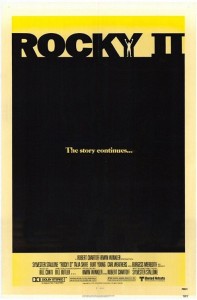 way, Balboa quickly squanders any sponsorship chances he had through illiteracy and poor acting skills. It’s tough to watch, yet Stallone’s unromantic approach feels right in the pocket for a character that we’ve come to know and love.
way, Balboa quickly squanders any sponsorship chances he had through illiteracy and poor acting skills. It’s tough to watch, yet Stallone’s unromantic approach feels right in the pocket for a character that we’ve come to know and love.
The descent is almost more tragic than that of the first film, but by contrast, it makes the victorious final act even more exciting. Apollo’s egotistical taunts for a rematch eventually do the trick, and Rocky’s forced to get back in shape in record time to compete. This time, Rocky’s run up the museum steps is joined by a flood of children, each cheering him on as he accelerates to an all-out sprint. Stallone’s subtle touch is brilliant here, contrasting the isolation of the original with the support of an entire city. In that final impassioned freeze frame, the viewer already knows who’s going to win this one.
The brawl is uglier than it was last time, and though Rocky spends most of it being pummeled, his undying will to win leaves him the last one standing. Bloody and teary eyed, his champion speech is a beautiful summation of the last two films. Much like the first two Godfather films, these initial Rocky pictures play out like continuous parts of the same story. An underrated entry in the series, and one that remains crucial to the Rocky pantheon.
Rocky III (1982)
“Hell, you ain’t be hungry since you won that belt!” – Mickey
Complacency. What if Rocky Balboa had lost his hunger to the champagne and commercials? Rocky III answers this question in the franchise’s first formulaic departure. This time, Rocky was the cheesy success story, knocking easy contenders around the ring while guest starring on Sesame Street. This new persona irked guys like Mickey and Paulie (Burt Young), who seemed 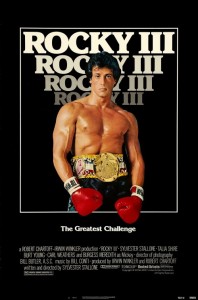 to be the only ones aware of Balboa’s flashy demise. But after a humiliating defeat at the hands of Clubber Lang (Mr. T), along with Mickey’s sudden death, Rocky becomes a man lost in his own insecurities. Fortunately, old enemy Apollo Creed had been there before, and he had a few pointers for The Italian Stallion.
to be the only ones aware of Balboa’s flashy demise. But after a humiliating defeat at the hands of Clubber Lang (Mr. T), along with Mickey’s sudden death, Rocky becomes a man lost in his own insecurities. Fortunately, old enemy Apollo Creed had been there before, and he had a few pointers for The Italian Stallion.
Rocky III might lay a claim as Stallone’s best directorial contribution to the series. By taking the boxer and tearing him off his cushy pedestal, Stallone cleverly restructured the franchise for a new decade of excess and fashion – Rocky Balboa was now a brand. And through implanting fear and guilt in Rocky’s head, the director showcased the other, uglier side of fame. There’s danger in failing to achieve goals, but there’s also danger in achieving those goals and becoming content.
With the aid of Apollo, Rocky comes back and defeats the vicious Clubber with rounds to spare. By readapting his brawler style to Creed’s fancier method, Rocky defeats his toughest opponent yet: personal doubt. Once again, it sounds corny, but try watching the Eye of the Tiger montage without feeling like you could punch out Mr. T. I dare you. Rocky III is a classic, and it gave depth to the series that went beyond being an underdog sensation.
Rocky IV (1985)
“All your strength, all your power, all your love. Everything you’ve got. Right now!” – Duke
While the last installment hinted at the notion, Rocky IV was the first time Balboa officially became invincible. This time, Stallone channeled the political upheaval of Soviet/U.S. relations into a fight that was bigger than any that had come before. Apollo, the bored former champ, is brutally killed in the ring during a charity match. His opponent, freakishly large Soviet 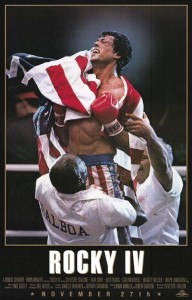 fighter Ivan Drago (Dolph Lundgren), is poised to take over the boxing world. That is, until Rocky decides to throw his Uncle Sam hat into the ring and honor the memory of his fallen friend.
fighter Ivan Drago (Dolph Lundgren), is poised to take over the boxing world. That is, until Rocky decides to throw his Uncle Sam hat into the ring and honor the memory of his fallen friend.
Backed by Adrian, Paulie, and Apollo’s trainer Duke (Tony Burton), Balboa heads off to Russia for an overseas serving of revenge. By this point, the subtlety of the original film is long gone, replaced by a bullet proof seal of symbolism and archetypes. Rocky, draped in Apollo’s flag shorts, embodies America, if that wasn’t already clear. But while it lacks the quiet grace of its predecessors, Rocky IV is a testosterone fueled blast. Its chalk full of 1980s filmmaking, and director Stallone has never been slicker with his use of montage or musical cues.
The training sequence, intercut between the cold machinery of Drago and the humanized passion of Rocky, are practically mythic in their personification. As for the David and Goliath fight itself, that’s where things get really crazy. No longer are we watching mere mortals punch it out, it’s now become a contest of God-like warriors that comes to a rip-roaring conclusion. Does Rocky win? Of course he does, and by that same accord, Democracy triumphs over Communism. Balboa had now become Captain America, the superhero of the 1980s. It’s not a masterpiece, but it is way too fun to simply dismiss as an inferior sequel.
Rocky V (1990)
“Come on, you can’t turn back the clock, ‘cause we live here, we live now.” – Adrian
If only Rocky V took Adrian’s advice more seriously. Released five years after the global super smash of Rocky IV, Stallone commissioned original Rocky director John G. Avildsen for a back to basics approach. In the pursuit of returning Rocky to square one, Avildsen saddled Balboa with brain damage, bankruptcy, and a return to the Philly slums. Sleazy promoter George 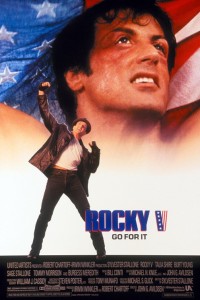 Washington Duke (Richard Gant) insists he can get Rocky back on top with a few fights, but the retired champ has sworn retirement for good. Especially when Rocky starts training up-and-comer Tommy Gunn (pro fighter Tommy Morrison).
Washington Duke (Richard Gant) insists he can get Rocky back on top with a few fights, but the retired champ has sworn retirement for good. Especially when Rocky starts training up-and-comer Tommy Gunn (pro fighter Tommy Morrison).
There’s plenty that goes wrong in Rocky V. The return to personal drama that distinguished Rocky II is weakly recaptured here, replaced with sitcom levels of family dispute. Stallone’s script attempts to incorporate tension between Rocky and his son Robert, Jr. (Sage Stallone), especially with the arrival of Tommy Gunn, but it annoys more than it endears. Speaking of annoying, boy can that Tommy Gunn not act. He’s a hot-headed jerk from the get go, and everyone except Balboa sees it, eventually leading to a back alley brawl between teacher and student. With both Gunn and the loud mouthed Duke, the film is jam packed with too many annoyances to truly hit it off with viewers.
It’s too bad John G. Avildsen was unable to capture the full circle vibe that the script was obviously striving for. He lays claim to not only directing the best Rocky picture, but also the worst. And I may just be splitting hairs, but not seeing the champ get in the ring was a major bummer. This misstep comfortably rests as the rotten apple in Rocky’s barrel.
Rocky Balboa (2006)
“If this is something you gotta do, then do it. Fighters fight.” – Marie
The Italian Stallion, made a has-been by the abomination that was Rocky V, was poised for a comeback. He deserved a much better send off than he got sixteen years prior, and writer/director/star Stallone thankfully gave it to him. Enter 2006’s Rocky Balboa, the beautiful swan song that proved it truly ain’t over until it’s over. Now a restaurant owner in Philly after Adrian’s 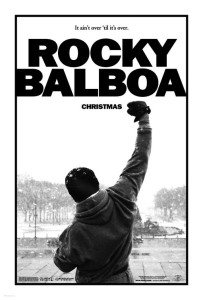 passing, Balboa spends most of his time taking photos with fans and shooting the breeze with Paulie. Then, just as it happened thirty years ago, heavyweight champ Mason “The Line” Dixon (pro fighter Antonio Tarver) cherry picks Balboa for a publicized charity fight, bringing the series full circle.
passing, Balboa spends most of his time taking photos with fans and shooting the breeze with Paulie. Then, just as it happened thirty years ago, heavyweight champ Mason “The Line” Dixon (pro fighter Antonio Tarver) cherry picks Balboa for a publicized charity fight, bringing the series full circle.
One of the most wonderful things about Rocky Balboa is how thoroughly it nails down a sense of completion. Rocky, without Adrian for the first time in decades, has once again become a lonely man. But with this fight, as with the original, relationships begin to build. New ones, like that of local girl Marie (the “screw you creepo” girl from the original) and her son, and renewed ones, like that of his own son Robert, Jr. (Milo Ventimiglia). And instead of youthful bulldog Butkus, Rocky is accompanied by aged pooch Punchy. As a graying mirror of the original, it’s delightful. As a culmination to the life and times of one Robert “Rocky” Balboa, it’s poetic.
The training montage is both hilarious and exhilarating, bringing out the kid in all of us who still wish we could chug raw eggs. Time has caught up with his body, but Rocky’s spirit remains as youthful as ever. As for the final fight with Dixon, it differs notably from most other matches in that it’s a triumph of emotion over physicality. Rocky loses, but for the first time since the original, winning wasn’t the endgame. As he comes out for one last curtain call, the validation is overwhelming. Even as an old man, he’s far more than “just another bum from the neighborhood.” He’s Rocky Balboa, the ordinary guy who proved we could all do extraordinary things.

